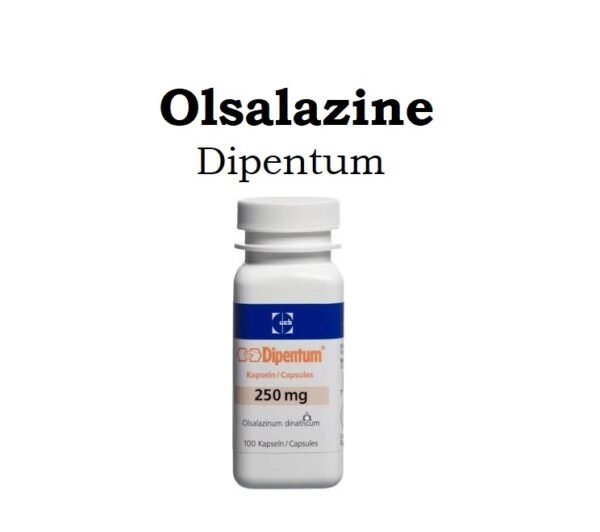Olsalazine (Dipentum) is a pro-drug that is metabolized by the colonic bacteria into the active metabolite 5-ASA (5-amino-salicylic acid) or mesalamine.
Olsalazine (Dipentum) Uses:
-
Maintenance Treatment of Ulcerative colitis:
- In adult patients with ulcerative colitis who cannot take sulfasalazine, it is advised for the maintenance of remission.
-
Off Label:
- Therapy of Ulcerative colitis:
Olsalazine (Dipentum) Dose in Adults
Olsalazine (Dipentum) Dose in the Maintenance Treatment of Ulcerative Colitis:
- 1 g/day in two equally divided doses.
Olsalazine (Dipentum) Dose in the treatment of Ulcerative colitis (off-label):
- 500 mg to 3 g/day orally in 2 equally divided doses.
Use in Children:
The drug's effectiveness and safety in youngsters have not been shown.
Pregnancy Risk Factor C
- In animal reproduction studies, fetal developmental toxicities were demonstrated.
- The drug has not been tested in human pregnancies.
- It should not be used if the benefits outweigh any risks. This is clearly stated.
Olsalazine use during breastfeeding:
- It is best to avoid it in breastfeeding women, as 5-aminosalicylic acids, the active metabolite of the product, can pass into breast milk and cause diarrhea.
Olsalazine (Dipentum) Dose in Kidney Disease:
No dosage adjustments have been provided in the manufacturer's labeling in patients with kidney disease.
Olsalazine (Dipentum) Dose in Liver Disease:
No dosage adjustments have been provided in the manufacturer's labeling in patients with liver disease.
Side Effects of Olsalazine (Dipentum):
-
Gastrointestinal:
- Diarrhea
Less Common Side Effects of Olsalazine (Dipentum):
-
Respiratory:
- Upper Respiratory Tract Infection
-
Central Nervous System:
- Vertigo
- Depression
- Dizziness
-
Gastrointestinal:
- Queasiness
- Bloating
- Abdominal Cramps
- Abdominal Pain
- Stomatitis
- Vomiting
-
Dermatologic:
- Skin Rash
- Pruritus
-
Neuromuscular & Skeletal:
- Arthralgia
Contraindications to Olsalazine (Dipentum):
Allergies to salicylates, olsalazine or any other component of the formulation
Warnings and precautions
-
Colitis
- Patients might notice a worsening of symptoms due to colitis, especially if the drug is being used to reduce the dosage.
-
Diarrhea:
- The treatment may cause diarrhea in some patients. This should be distinguished from worsening diseases activity.
-
Asthma
- The drug should not be used by patients suffering from severe allergies or asthma.
-
Hepatic impairment
- Patients with hepatic impairment must be warned and should be closely monitored.
-
Renal impairment
- Patients with impaired renal function should be warned and closely monitored.
Olsalazine: Drug Interaction
Note: Drug Interaction Categories:
- Risk Factor C: Monitor When Using Combination
- Risk Factor D: Consider Treatment Modification
- Risk Factor X: Avoid Concomitant Use
Risk Factor C (Monitor therapy) |
|
| Cardiac Glycosides | Cardiac Glycoside serum levels may be lowered by 5-aminosalicylic acid derivatives. |
| Heparin | The negative/toxic effects of heparin may be increased by derivatives of 5-aminosalicylic acid. In particular, there may be a higher chance of bleeding or bruising. |
| Heparins (Low Molecular Weight) | The negative or toxic effects of heparins may be increased by derivatives of 5-aminosalicylic acid (Low Molecular Weight). In particular, there may be a higher chance of bleeding or bruising. |
| Nonsteroidal Anti-Inflammatory Agents | May make 5-Aminosalicylic Acid Derivatives more nephrotoxic. |
| Thiopurine Analogs | Thiopurine Analog Metabolism may be decreased by 5-Aminosalicylic Acid Derivatives. |
Risk Factor D (Consider therapy modification) |
|
| Varicella Virus-Containing Vaccines | Varicella virus-containing vaccines may have a more negative or hazardous effect when combined with 5-aminosalicylic acid derivatives. The main issue is the probable occurrence of Reye's Syndrome, a disorder linked to the use of salicylates in children with varicella infections. |
Monitoring Parameters:
- CBC
- Liver function tests and Renal function tests before treatment initiation, at 6 and 12 months during treatment, and yearly thereafter.
- Monitor stool frequency
- Observe for improvement in the clinical signs and symptoms of ulcerative colitis
How to administer Olsalazine (Dipentum)?
Administer the drug with food in equally divided doses
Mechanism of action of Olsalazine (Dipentum):
- The active component of olsalazine is 5-aminosalicylic acid (Mesalamine).
- It acts locally as a free radical scavenger, inhibiting inflammation by inhibiting the release of local chemical mediators, particularly leukotrienes.
- It also inhibits TNF (tumour-necrosis factor) release at the site of inflammation.
Half-life elimination:
- 54 minutes
Plasma Protein binding of the absorbed drug:
- The majority of the medication that is absorbed is bonded to plasma proteins.
Excretion:
- Primarily feces
- urine (<1%)
Metabolism:
- Colonic bacteria in the digestive system metabolise it locally to produce 5-aminosalicylic acid (5-ASA), which is the substance's active metabolite.
Time to peak:
- About one hour
Absorption:
- Less than 3% of the drug is absorbed systemically.
International Brands of Olsalazine:
- Dipentum
- Chang Mei
- Motilsalin
- Olsanium
- Ulcecoloct
Olsalazine Brand Names in Pakistan:
No Brands Available in Pakistan.







